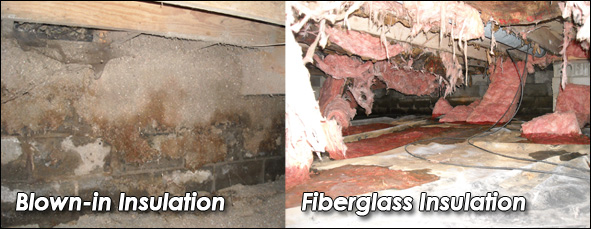
Bad Insulation Practices in a Crawlspace
Over the past couple decades, The Crawlspace Company has seen many different insulation practices in crawlspaces. Since there is only one approach that works best (sealed, unventilated crawlspace), we wanted to share with you what we have seen why it doesn’t work.
1. Insulating the crawlspace walls with fiberglass insulation – Usually this will consist of taking strips of fiberglass bats and running them vertically along the crawlspace wall from the floor joist cavity down to the ground floor of the crawlspace. This method will usually soak up all of the moisture from the ground and foundation wall and “wick” up through the insulation into the wood framing components (joists, sill plates, and subfloor). When the fiberglass insulation becomes saturated with moisture, it has no r value and will not insulate the wall. Another problem is that fiberglass insulation work best in a closed cavity (ie stud wall).
2. Spray Foam on the crawlspace walls – In a dry below-grade crawlspace this method is the most energy efficient. The problem is that in most below-grade crawlspaces, the foundation or ground floor of the crawlspace is NOT dry. In fact, a majority of the crawlspaces we run across with spray foam have some form of dry rot in the structural components because the foam has trapped the moisture in the wood. It is not uncommon to see the spray foam become separated from the wall from the moisture intrusion. Unless the crawlspace has external footing drains, a foundation waterproofing membrane, a foundation sealant, positive grade, and downspout extensions, we cannot ever recommend this method of insulation.
3. Reflective barrier or plastic on crawlspace ceiling – In a sealed, encapsulated crawlspace, a reflective barrier can be effective. The problem lies in installing plastic or any type of barrier along the bottom of the joists in a ventilated crawlspace. In the warmer months, ducts and pipes will condensate, and the plastic barrier will trap this water against the wood. Over time, mold will begin to grow and wood will begin to rot.
4. Fiberglass insulation in the floor joists – The most common approach to insulating a crawlspace for decades. In many older homes, the fiberglass insulation has been replaced two and sometime three times by now. The reason is because fiberglass was not meant to be in a damp, ventilated environment. Once the humidity reaches a certain level in the crawlspace, the fiberglass will soak up this moisture like a sponge. Once the fiberglass becomes wet, it will fall to the floor needing to be replaced. Also, paper backed fiberglass has been called “mold candy” by building scientists because mold loves paper more than wood. As a result of the fiberglass falling, many contractors have held it up with chicken wire or wood 1×2 slats. This results in holding a moist sponge in the joist cavity and wreaks havoc on the floor components.
5. Blown in cellulose insulation on crawlspace walls – Cellulose is a wood material and like all cellulose materials, mold and termites thrive on them. Cellulose should have a minimum clearance of 12″ to 18″ of the ground floor of the crawlspace, but rarely it is applied in this manner. Even if it is kept free from the ground, when the moisture intrusion through the foundation occurs, the cellulose will fall off and sit on the moist ground floor of the crawlspace.
The Crawlspace Company has seen more damage done to the wood framing as a result of bad insulation practices especially in homes with electric baseboard heat and not forced air. Give us a call Today to schedule a Free Inspection from one of our Crawlspace Insulation Professionals.
